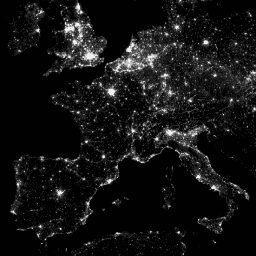
- 데이터 세트 사용 가능 기간
- 1996-03-16T00:00:00Z–2011-07-31T00:00:00Z
- 데이터 세트 제공업체
- 지구 관측 그룹, 콜로라도 광산 학교 공공 정책 페인 연구소
- 태그
설명
국방 기상 프로그램 (DMSP) 운영 라인 스캔 시스템(OLS)은 밤에 가시광선 및 근적외선 (VNIR) 방출 소스를 감지하는 고유한 기능을 갖추고 있습니다.
이 컬렉션에는 센서 포화가 없는 전역 야간 조명 이미지가 포함되어 있습니다. 센서는 일반적으로 달빛이 비치는 구름을 감지할 수 있도록 높은 게인 설정으로 작동합니다. 하지만 6비트 양자화와 제한된 동적 범위로 인해 기록된 데이터는 도시 중심부의 밝은 코어에서 포화됩니다. 탐지기의 게인이 일반적인 작동 설정보다 훨씬 낮게 설정된 (때로는 100배) 낮은 달 조명에서 제한된 관측 세트가 획득되었습니다. 낮은 게인 설정에서 획득한 스파스 데이터는 높은 게인 설정에서 획득한 운영 데이터와 결합되어 센서 포화가 없는 전역 야간 조명 이미지 세트를 생성했습니다. 최대 범위를 확보하기 위해 서로 다른 위성의 데이터가 최종 제품으로 병합되고 혼합되었습니다. 자세한 내용은 제공업체의 이 리드미 파일을 참고하세요.
NOAA의 National Geophysical Data Center에서 이미지와 데이터를 처리합니다. 미국 공군 기상청에서 수집한 DMSP 데이터입니다.
대역
픽셀 크기
927.67미터
대역
| 이름 | 최소 | 최대 | 픽셀 크기 | 설명 |
|---|---|---|---|---|
avg_vis |
0* | 6060.6* | 미터 | 구름이 없는 빛 감지 관측의 평균 디지털 밴드 번호입니다. |
cf_cvg |
0* | 175* | 미터 | 구름이 없는 커버리지, 각 30초 그리드 셀에 포함된 총 관측 수입니다. 이 이미지를 사용하여 품질이 저하된 관측 수가 적은 영역을 식별할 수 있습니다. |
이용약관
이용약관
NOAA 데이터, 정보, 제품은 전송 방법에 관계없이 저작권이 적용되지 않으며 일반인의 후속 사용에 제한이 없습니다. 획득한 후에는 합법적인 용도로 사용할 수 있습니다. 위의 데이터는 퍼블릭 도메인에 속하며 사용 및 배포에 제한 없이 제공됩니다.
Earth Engine으로 탐색하기
코드 편집기(JavaScript)
var dataset = ee.ImageCollection('NOAA/DMSP-OLS/CALIBRATED_LIGHTS_V4') .filter(ee.Filter.date('2010-01-01', '2010-12-31')); var nighttimeLights = dataset.select('avg_vis'); var nighttimeLightsVis = { min: 3.0, max: 60.0, }; Map.setCenter(7.82, 49.1, 4); Map.addLayer(nighttimeLights, nighttimeLightsVis, 'Nighttime Lights');
